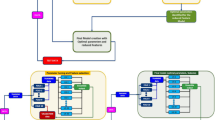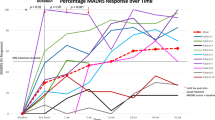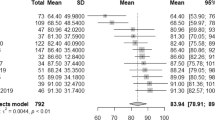Abstract
Remission of depressive symptoms is the goal of all antidepressant therapy. Rating scales define remission in clinical trials, but it is unclear how well these definitions predict risk of later relapse. We measured the sensitivity and specificity of a range of Montgomery–Asberg Depression Rating Scale (MADRS) cutoff scores at 3- and 6-months, wherein scores above a given cutoff would predict relapse over an 18-month period. We examined 153 elderly depressed subjects exhibiting a MADRS ⩽15 after 3 or 6 months of antidepressant therapy. Subjects who subsequently exhibited a MADRS >15 during the 18-month study period were defined as relapsed. Receiver operating characteristic (ROC) curves were developed and area under the curve (AUC) values calculated for the sensitivity and specificity of 3- and 6-month MADRS scores to predict future relapse. The 3-month ROC had an AUC value of 0.63; the 6-month ROC had an AUC value of 0.66. There was no MADRS cutoff found that could predict likelihood of relapse with good sensitivity and specificity. A post hoc analysis where relapse rate was adjusted by controlling for medical comorbidity, disability, and social support showed no change in the ROCs or AUC values. The higher the MADRS score at 3 and 6 months, the greater the likelihood of relapse. With no clean MADRS cutoff score, the goal of antidepressant therapy should be the lowest possible degree of depressive symptomatology to minimize risk of later relapse. Definitions of remission that are better associated with longer-term outcomes are needed.
Similar content being viewed by others
Log in or create a free account to read this content
Gain free access to this article, as well as selected content from this journal and more on nature.com
or
References
Alexopoulos GS, Meyers BS, Young RC, Kalayam B, Kakuma T, Gabrielle M et al (2000). Executive dysfunction and long-term outcomes of geriatric depression. Arch Gen Psychiatry 57: 285–290.
Ballinger JC (1999). Clinical guidelines for establishing remission in patients with depression and anxiety. J Clin Psychiatry 60 (Suppl 22): 29–34.
Bosworth HB, Hays JC, George LK, Steffens DC (2002). Psychosocial and clinical predictors of unipolar depression outcome in older adults. Int J Geriatr Psychiatry 17: 238–246.
Folstein MF, Folstein SE, McHugh PR (1975). Mini-mental state' a practical method for grading the cognitive state of patients for the clinician. J Psychiatr Res 12: 189–198.
Frank E, Prien RF, Jarrett RB, Keller MB, Kupfer DJ, Lavori PW et al (1991). Conceptualization and rationale for consensus definitions of terms in major depressive disorder. Remission, recovery, relapse, and recurrence. Arch Gen Psychiatry 48: 851–855.
George LK, Blazer DG, Hughes DC, Fowler N (1989). Social support and the outcome of major depression. Br J Psychiatry 154: 478–485.
Guy W (1976). Clinical global impressions. In: ECDEU Assessment Manual for Psychopharmacology, Revised. Rockville, MD: U.S. Department of Health, Education, and Welfare, National Institute of Mental Health. pp 217–222.
Hamilton M (1960). A rating scale for depression. J Neurol Neurosurg Psychiatry 23: 56–62.
Hawley CJ, Gale TM, Sivakumaran T (2002). Defining remission by cut off score on the MADRS: selecting the optimal value. J Affect Disord 72: 177–184.
Horwath E, Johnson J, Klerman GL, Weissman MM (1992). Depressive symptoms as relative and attributable risk factors for first-onset major depression. Arch Gen Psychiatry 49: 817–823.
Judd LL, Akiskal HS, Paulus MP (1997). The role and clinical significance of subsyndromal depressive symptoms (SSD) in unipolar major depressive disorder. J Affect Disord 45: 5–18.
Krishnan KRR (2003). Comorbidity and depression treatment. Biol Psychiatry 53: 701–706.
Landerman R, George LK, Campbell RT, Blazer DG (1989). Alternative models of the stress buffering hypothesis. Am J Comm Psychol 17: 626–642.
Linn BS, Linn MW, Gurel L (1968). Cumulative Illness Rating Scale. J Am Geriatr Soc 16: 622–626.
Maier W, Gansicke M, Weiffenbach O (1997). The relationship between major and subthreshold variants of unipolar depression. J Affect Disord 45: 41–51.
Miller MD, Lenze EJ, Dew MA, Whyte E, Weber E, Begley AE et al (2002). Effects of cerebrovascular risk factors on depression treatment outcomes in later life. Am J Geriatr Psychiatry 10: 592–598.
Miller MD, Paradis CF, Houck PR, Mazumdar S, Stack JA, Rifai AH et al (1992). Rating chronic medical illness burden in geropsychiatric practice and research: application of the Cumulative Illness Rating Scale. Psychiatry Res 41: 237–248.
Montgomery SA, Asberg M (1979). A new depression scale designed to be sensitive to change. Br J Psychiatry 134: 382–389.
Nierenberg AA, Wright EC (1999). Evolution of remission as the new standard in the treatment of depression. J Clin Psychiatry 60 (suppl 22): 7–11.
Paykel ES, Ramana R, Cooper Z, Hayhurst H, Kerr J, Barocka A (1995). Residual symptoms after partial remission: an important outcome in depression. Psychol Med 25: 1171–1180.
Robins LN, Helzer JE, Croughan J, Ratcliff KS (1981). National Institute of Mental Health Diagnostic Interview Schedule. Its history, characteristics, and validity. Arch Gen Psychiatry 38: 381–389.
Rosow I, Breslau N (1966). A Guttman health scale for the aged. J Gerontol 21: 556–559.
Steffens DC, Hays JC, Krishnan KRR (1999). Disability in geriatric depression. Am J Geriatr Psychiatry 7: 34–40.
Steffens DC, McQuoid DR, Krishnan KRR (2002). The Duke Somatic Treatment Algorithm for Geriatric Depression (STAGED) approach. Psychopharmacol Bull 36: 58–68.
Steffens DC, McQuoid DR, Krishnan KRR (2003). Partial response as a predictor of outcome in geriatric depression. Am J Geriatr Psychiatry 11: 340–348.
Thase ME (1999). Introduction: defining remission in patients treated with antidepressants. J Clin Psychiatry 60 (suppl 22): 3–6.
Thase ME (2001). The clinical, psychosocial, and pharmacoeconomic ramifications of remission. Am J Manag Care 7 (11 suppl): S377–S385.
Van Londen L, Molenaar RPG, Goekoop JG, Zwinderman AH, Rooijmans HGM (1998). Three- to 5-year prospective follow-up of outcome in major depression. Psychol Med 28: 731–735.
Acknowledgements
This study was supported by a NARSAD Young Investigator Award and NIMH grants K23 MH65939, R01 MH54846, and P50 MH60451.
Author information
Authors and Affiliations
Corresponding author
Rights and permissions
About this article
Cite this article
Taylor, W., McQuoid, D., Steffens, D. et al. Is there a Definition of Remission in Late-Life Depression that Predicts Later Relapse?. Neuropsychopharmacol 29, 2272–2277 (2004). https://doi.org/10.1038/sj.npp.1300549
Received:
Revised:
Accepted:
Published:
Issue date:
DOI: https://doi.org/10.1038/sj.npp.1300549
Keywords
This article is cited by
-
Naturalistic outcome of treatment of psychosis by traditional healers in Jinja and Iganga districts, Eastern Uganda – a 3- and 6 months follow up
International Journal of Mental Health Systems (2012)
-
Model-Based Approach and Signal Detection Theory to Evaluate the Performance of Recruitment Centers in Clinical Trials With Antidepressant Drugs
Clinical Pharmacology & Therapeutics (2008)



